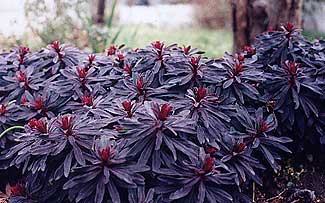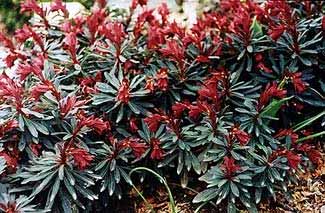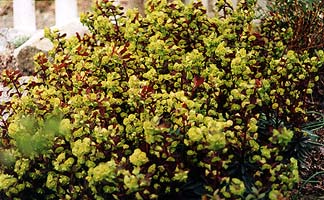 Purple Wood Spurge
Purple Wood Spurge
"Blazing in Gold & quenching in Purple
Leaping like Leopards to the Sky."
-Emily Dickinson
(1830-1886)
(1830-1886)
Euphorbia amygdaloides 'Purpurea,' or Purple Wood Spurge, is the most popular of the many Wood Spurge cultivars . I just loved watching our patch of it spread & grow & go through radical seasonal changes.
It adores full sun, preferably with moist well drained soil, so ours was originally planted along a sunny rock garden's ledge where it got plenty of water running down to it from some nearby rhododendrons. It would also do well in shadier locations, though in deep shade it may remain greener & not age into the stunning coloration that develops as it experiences autumn & winter in the sunlight. The January portrait to the left above shows how the stems & uppermost leaves mature to red, the rest of the leaves ranging from mahogony to purple.
 Strange as it may seem, the three portraits on this page are all from that very same stand of purple spurge, changing fantastically from month to month.
Strange as it may seem, the three portraits on this page are all from that very same stand of purple spurge, changing fantastically from month to month.The second portrait at right was taken early in March & shows the mahagony coloration has turned green as Spring approaches, but with addition of new growth that is so fluffy & extremely wine-colored that its upper leaves look like blossoms. By the end of March & throughout April, there is a charming color reversal compared to most flowering plants, as spurge produces lime-green to yellow-green blooms atop the rosettes of red or purple leaves. The third photo at the bottom of this page was taken early April with the green blooms dense enough to obscure the plant overall.
In 1870, Dante Gabrielle Rosetti wrote his famous ode to Wood Spurge, which grows wild in woodland glades of England:
The wind flapped loose, the wind was still,
Shaken out dead from tree & hill:
I had walked on at the wind's will —
I sat now, for the wind was still.
Between my knees my forehead was —
My lips, drawn in, said not Alas!
My hair was over in the grass,
My naked ears heard the day pass.
My eyes, wide open, had the run
Of some ten weeds to fix upon;
Among those few, out of the sun,
The woodspurge flower'd, three cups in one.
From perfect grief there need not be
Wisdom or even memory:
One thing then learnt remains to me —
The woodspurge has a cup of three.
 Wood Spurge on rare occasions grows to nearly three feet in height, though it's lower stems can occasionally get bare & rangy as it ages or becomes too tall, taking on the appearance of miniature palm trees. Our patch of it remained around 18 inches tall & quite fluffy top to bottom. It spread densely along the ridge of its sunny rock garden, & apparently self-seeded quite a bit, as tiny starts of purple wood spurge popped up in unexpected places.
Wood Spurge on rare occasions grows to nearly three feet in height, though it's lower stems can occasionally get bare & rangy as it ages or becomes too tall, taking on the appearance of miniature palm trees. Our patch of it remained around 18 inches tall & quite fluffy top to bottom. It spread densely along the ridge of its sunny rock garden, & apparently self-seeded quite a bit, as tiny starts of purple wood spurge popped up in unexpected places.It is a most adaptable plant in a wide range of soils in cold to temperate climates. I have seen an excellent recommendation that it be incorporated in "winter container gardening" with black mondo grass & Carex aureola which is a golden grass, to have a winter container almost as colorful as those prepared for spring & summer flowerings. I do very little container gardening, but was quite taken with the possibilities of winter containers reliant on unusually colored little evergreens.
By its fourth spring in the ground (in 2003), rhodies & other shrubs had grown up around the patch of wood spurge, & its formerly ideal sunny conditions were now more suited to plants that love dappled sunlight & shade. The nature of the larger surrounding garden had transmuted over time, so that it really needed more regular watering than the euphorbia liked. I kept delaying a decision as to whether or not to move or discard the euophorbia.
It is often the case that older wood spurges are difficult to keep attractive. What had for two years been so remarkable in its changing beauties in its third & fourth years increasingly prone to dead undersides, scruffy foliage, & I could never figure out an ideal time to trim it back that it would be guaranteed to grow back beautifully. When its flowers dried out, I cut the very worn-looking euphorbia patch back dramatically, but it regrew so unevenly, & simply never regained its youthful beauty.
So about April 2003 I moved two clumps of euphorbia to two new locations where they stick out of walls from between rocks. I gave away another enormous clump to a friend while it was in full flower. There was still a lot of it remaining, but late in June I dug up the rest of it & put it in two large containers where it could remain until I could decide whether to compost it, plant it on the roadside, or what. A species rhododendron that had been long in a container got put in the euphorbia's old space, & there's room yet for I'm not sure what.
If I dwell on it too long I can make myself feel guilty for evicting a plant that had rewarded me so beautifully for quite some while, as I sure wouldn't like it if my sweety evicted me just because I've gotten a bit old & scruffy.